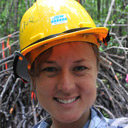A PALM OIL PARADOX
One way to start is to assist farmers to intensify production – to make more oil from the land they are already cultivating
Here, there is huge potential for improvement on two fronts, Ordway says.
“So much of the production is on very small-scale farms, by farmers who are often limited in terms of their access to technology or information, so yields on these farms are very low compared to what they could be.”
In addition, the artisanal mills can be very inefficient, and improving those processes could greatly increase the output of oil. Giving farmers access to finance and assistance could enable them to make these improvements, says Sonwa.
However, “intensification is not inherently a sustainability path,” Ordway cautions. She explains there’s a risk of something called the ‘Jevons paradox’ – that increased profitability from intensification can ultimately incentivize further expansion.
“If production was increased, whether on-farm or at the milling stage or both, one of the positive results of that would be increased income for a farmer. However, Ordway prophesizes, that the farmer could think, ‘I’m now making more money from the same amount of land, but if I cleared more land, I could make even more money.”
Intensification could help Congo Basin countries to meet food security and poverty alleviation goals, she says, but to avoid that coming at the cost of forest and biodiversity loss, additional environmental policies will be required as well.
That could be land-use regulations or other tactics, but will vary depending on the local and national context, says Sonwa.
“Trying to prevent oil palm development in Africa is a lost fight. Looking for win-win – or at least lose-less – solutions are the only viable alternatives”
“Our role as scientists is to spell out the situation so that different stakeholders can know what their options are.”
Patrice Levang has studied oil palm on both continents. “The oil palm expansion in Southeast Asia happened at the expense of both primary and secondary forests, and had a disastrous impact on biodiversity and animal habitat,” he says.
“On the other hand, it promoted incredible economic development – and like it or not, African policy-makers and farmers are going to be more inclined to favor economic development than biodiversity conservation.”
“Trying to prevent oil palm development in Africa is a lost fight. Looking for win-win – or at least lose-less – solutions are the only viable alternatives.”
There are some early signs that the Congo Basin’s leaders are already paying attention to the potential environmental trade-offs of oil palm expansion – like the Marrakesh Declaration, in which seven African governments pledge a shift towards sustainable, low-carbon palm oil production.
Preventing palm oil’s history from repeating will require regional pledges like this be kept.
Read also: Oil palm landscapes: Playing the long game with palm oil
Read also: Replanting the oil palm to save forests
Read also: Oil palm research for sustainable development and better livelihoods
This research was supported by the Stanford Center on Food Security and the Environment (FSE) and the Center for International Forestry Research (CIFOR) Internship Program in Yaoundé, Cameroon. The research undertaken was part of the CGIAR research program on Forests, Trees, and Agroforestry (FTA) and was done within the Global Comparative Study on REDD+ (GCS REDD+) funded by NORAD (Norwegian Agency for Development Cooperation).
Copyright policy:We want you to share Forests News content, which is licensed under Creative Commons
Attribution-NonCommercial-ShareAlike 4.0 International (CC BY-NC-SA 4.0). This means you are free to redistribute our material for non-commercial purposes. All we ask is that you give Forests News appropriate credit and link to the original Forests News content, indicate if changes were made, and distribute your contributions under the same Creative Commons license. You must notify Forests News if you repost, reprint or reuse our materials by contacting
forestsnews@cifor-icraf.org.














